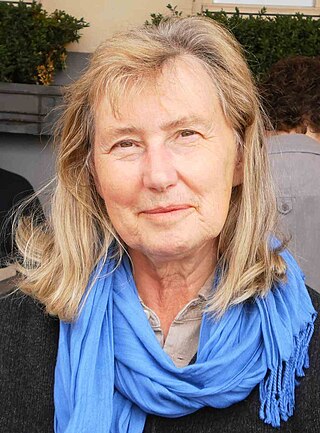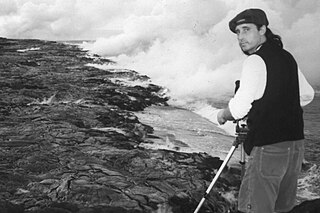Video art is an art form which relies on using video technology as a visual and audio medium. Video art emerged during the late 1960s as new consumer video technology such as video tape recorders became available outside corporate broadcasting. Video art can take many forms: recordings that are broadcast; installations viewed in galleries or museums; works streamed online, distributed as video tapes, or DVDs; and performances which may incorporate one or more television sets, video monitors, and projections, displaying live or recorded images and sounds.

The Turner Prize, named after the English painter J. M. W. Turner, is an annual prize presented to a British visual artist. Between 1991 and 2016, only artists under the age of 50 were eligible. The prize is awarded at Tate Britain every other year, with various venues outside of London being used in alternate years. Since its beginnings in 1984 it has become the UK's most publicised art award. The award represents all media.

Vorticism was a London-based modernist art movement formed in 1914 by the writer and artist Wyndham Lewis. The movement was partially inspired by Cubism and was introduced to the public by means of the publication of the Vorticist manifesto in Blast magazine. Familiar forms of representational art were rejected in favour of a geometric style that tended towards a hard-edged abstraction. Lewis proved unable to harness the talents of his disparate group of avant-garde artists; however, for a brief period Vorticism proved to be an exciting intervention and an artistic riposte to Marinetti's Futurism and the post-impressionism of Roger Fry's Omega Workshops.

The Quantel Paintbox was a dedicated computer graphics workstation for composition of broadcast television video and graphics. Produced by the British production equipment manufacturer Quantel, its design emphasized the studio workflow efficiency required for live news production.

David Hall was an English artist, whose pioneering work contributed much to establishing video as an art form.
Paul Noble is a British visual artist.
London Video Arts (LVA) was founded for the promotion, distribution and exhibition of video art.

Dundee Contemporary Arts (DCA) is an art centre in Dundee, Scotland, with two contemporary art galleries, a two-screen cinema, a print studio, a learning and public engagement programme, a shop and a café bar.

Duncan of Jordanstone College of Art & Design (DJCAD) is part of the University of Dundee in Dundee, Scotland. It is ranked as one of the top schools of art and design in the United Kingdom.

Jackie Hatfield was an artist, writer, and academic. According to the influential artist-led no.w.here website: "Jackie Hatfield is an artist and writer who makes expanded and participatory cinematic artworks using digital video, performance, sound and digital print. She has co-edited two critical books around women's use of technology in art practice and has published essays that concentrate on under-explored histories of experimental film and video practices."

Elaine Shemilt is a British artist and researcher especially known as a fine art printmaker.

Mike Stubbs is a curator/director and filmmaker based in the UK, currently, the Creative Producer at Doncaster Creates. For 11 years he was the Director/CEO of FACT, the Foundation for Art and Creative Technology, a leading arts organisation for the commissioning and presentation of new media art forms. He has been a key contributor to the development of culture and cultural policy in Liverpool, UK. Stubbs was jointly appointed in May 2007 by Liverpool John Moores University, where he is Professor of Art, Media and Curating. He is father to two daughters Saskia and Lola Czarnecki-stubbs.

Else Madelon Hooykaas is a Dutch video artist, photographer and film maker. She makes films, sculptures, audio-video installations and has published several books.

Chris Meigh-Andrews is a video artist, writer and curator from Essex, England, whose work often includes elements of renewable energy technology in tandem with moving image and sound. He is currently Professor Emeritus in Electronic & Digital Art at the University of Central Lancashire and Visiting Professor at the Centre for Moving image Research (CMIR) at the University of the West of England.
Sarah Pucill is a London-based film artist. Her work is distributed by LUX, London and LightCone, Paris. She is a Reader at University of Westminster. Central to her work is "a concern with mortality and the materiality of the filmmaking process". Much of her work appears within the restrictions of domestic spaces. In her "explorations of the animate and inanimate, her work probes a journey between mirror and surface".

Tamara Seta Krikorian was a British video artist and a public art curator.
Catherine Elwes is a British artist, curator and critic working predominantly in the field of video art and a significant figure in the British feminist art movement. She was born in St Maixent, France. She studied at the Slade School of Fine Art and later graduated with an MA in Environmental Media from the Royal College of Art. She began working with video in the late 1970s. In 1979 Elwes performed Menstruation II, a three-day performance at the Slade which lasted for the duration of a menstrual period.
Alex Frost is a British contemporary artist, exhibiting internationally.

Kent Tate is a Canadian artist and filmmaker living in British Columbia. Tate is known for his single-channel video installation works.
Peter Donebauer is an English video artist best known for his video artwork 'Entering', part two of his seven-part 'Creation Cycle’, 1972–1978. He also designed and built the Videokalos video synthesizer.














